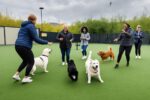Mastering Fetch and Frisbee Games with Your Dog

Playing fetch and Frisbee games with your dog is not only a fun and exciting playtime activity but also provides numerous benefits for both you and your furry companion. Exercise and mental stimulation are essential for dogs to lead a happy and healthy life, and these games offer a perfect opportunity to fulfill these needs.
When it comes to fetch, dogs of all breeds can be taught to retrieve a ball or a Frisbee. However, if you specifically want to engage in Frisbee games, there are specialized discs available for different types of dogs. It’s important to start training at an early age using a miniature disc, gradually progressing to larger ones as your dog develops their skills.
During playtime, dogs not only exercise their bodies but also engage their minds. The science behind play reveals that it provides mental stimulation by encouraging problem-solving, decision-making, and honing their instincts. These games also serve as a means to curb destructive behavior, channeling your dog’s energy into productive activities.
Key Takeaways:
- Playing fetch and Frisbee games offers both physical exercise and mental stimulation for your dog.
- Training your dog to fetch a Frisbee can start from an early age using a miniature disc.
- Engaging in these games helps curb destructive behavior and strengthens the bond between you and your dog.
- Playing stimulates your dog’s mind, providing opportunities for problem-solving and decision-making.
- Frisbees are available in various sizes, tailored to different breeds.
The Science Behind Play
Playtime for dogs is not just about having fun; it also serves as a way to provide physical exercise and mental stimulation. Engaging in play with your dog helps build a deeper emotional connection and fosters mutual respect.
Dogs have different preferences when it comes to play activities, so it’s important to observe and understand your dog’s body language and preferences. By paying attention to their cues, you can tailor playtime to their likes and dislikes, ensuring they have the most enjoyable experience.
Physical exercise during play helps dogs maintain a healthy weight, promotes cardiovascular health, and strengthens their muscles and joints. It also aids in the release of pent-up energy, reducing the likelihood of destructive behavior caused by boredom or excess energy.
In addition to physical exercise, playtime provides essential mental stimulation for dogs. It engages their senses, challenges their problem-solving skills, and promotes overall cognitive development. Mental stimulation is particularly crucial for intelligent breeds such as Border Collies and Poodles, as it helps prevent boredom and associated behavior issues.
Each dog has their own preferences when it comes to play. Some may enjoy chasing balls or playing tug-of-war, while others may prefer interactive puzzle toys or participating in agility courses. By finding activities that align with their preferences, you can ensure a more fulfilling play experience for both you and your pet.
Playing with your dog not only provides physical and mental benefits but also strengthens the bond between you. It’s a time of shared joy and laughter, where you get to know and understand each other better. Through play, you communicate with your dog in a language they understand, fostering mutual trust and respect.
“Playtime is an essential aspect of a dog’s overall well-being and happiness. It allows them to express their natural instincts, release energy, and engage in enriching experiences.” – Dr. Emily Parker, Canine Behavior Specialist
Dog Play Techniques: Finding the Right Game
Every dog is unique, with their own preferences and instincts when it comes to playtime. To ensure an enjoyable experience, it’s crucial to find the right game that aligns with your dog’s specific needs. Whether you have a guardian dog breed or a calm American Mastiff, tailoring the play experience to their preferences is key.
Guardian dog breeds, such as German Shepherds or Rottweilers, often enjoy games that channel their protective instincts. Activities like tug-of-war or fetch with a durable rope toy can help engage their natural instincts while providing a physical challenge.
On the other hand, calm and intelligent breeds like the American Mastiff may prefer games that stimulate their minds rather than relying solely on physical strength. Interactive puzzle toys or hide-and-seek games can help engage their problem-solving skills and provide mental stimulation.
Remember, safety should always come first when selecting toys and games for your dog. Consider their size and temperament to ensure that the toys you choose are appropriate and free from any potential hazards.
Customized Play for Your Dog
When customizing play for your furry friend, consider their physical abilities, energy levels, and individual preferences. It’s essential to engage in activities that your dog enjoys and feels comfortable with.
Here are some play techniques that can be customized based on your dog’s needs:
- Fetch and Retrieval: If your dog loves to chase and retrieve, use a tennis ball or a specially designed fetching toy to engage their natural instincts.
- Tug-of-War: This interactive game can help build a bond while providing a physical challenge. Select a durable tug toy that can withstand their strength.
- Hide-and-Seek: Hide treats or toys around the house or yard to encourage your dog to use their sense of smell and problem-solving skills.
- Interactive Puzzle Toys: These toys stimulate your dog’s mental capabilities and keep them entertained for hours. Fill them with treats or food to challenge their problem-solving abilities.
Remember to actively observe your dog’s body language and adjust the play accordingly. Tail wagging, play bows, and excited vocalizations are positive signs that they are enjoying the game.
By finding the play techniques that align with your dog’s preferences and instincts, you can create a fun and engaging playtime experience that strengthens the bond between you and your furry companion.
| Benefits of Customized Play | How to Customize |
|---|---|
| 1. Mental stimulation | 1. Observe your dog’s preferences |
| 2. Physical exercise | 2. Consider their size and energy levels |
| 3. Bonding and trust-building | 3. Adapt activities to their physical abilities |
| 4. Channeling instincts | 4. Provide a variety of play options |
Why Play Matters: More than Just Fun and Games
Playtime is not just a source of fun for dogs; it plays a significant role in their overall well-being. Dogs use play to understand their world better, establish hierarchies, and build a closer bond with their human companions. It is a critical aspect of their physical and mental development.
During play, dogs utilize various forms of communication to express their emotions and intentions. Whiskers help dogs navigate their surroundings, acting as sensitive detectors of movement and objects. Canine vocalizations, such as barks, growls, and howls, convey different messages and indicate their current mood or needs. Tail language provides additional insights, with different positions and movements indicating excitement, fear, or contentment.
Play safety is paramount to ensure a fun and enjoyable experience for both dogs and their owners. Choosing the right toys that are appropriate for your dog’s size, age, and temperament is essential. It is important to prioritize durability and avoid toys with small parts that can be easily swallowed. Regularly inspecting toys for wear and tear, replacing them when necessary, helps prevent any potential accidents or injuries.
Play is an interactive language that dogs share with humans, allowing them to communicate, learn, and grow together.
The Importance of Play Safety
Play safety should always be a top priority when engaging in playtime activities with your dog. Here are a few key tips to ensure a safe play environment:
- Supervise your dog during play sessions to prevent any potential accidents or injuries.
- Choose toys that are specifically designed for dogs and avoid using objects that could be harmful, such as sticks or small balls that can be easily swallowed.
- Regularly inspect toys for any signs of damage or wear and tear. Replace them if necessary to prevent choking hazards.
- Provide a safe and secure play area, free from any potential hazards or harmful substances.

Building a Stronger Bond
Playtime offers an opportunity to strengthen the bond between dogs and their human companions. It allows for positive interactions and fosters trust, love, and companionship. Through play, dogs learn to understand their owner’s cues and vice versa, establishing effective communication and deepening the emotional connection.
By engaging in play with your dog, you not only provide physical exercise and mental stimulation but also create joyful memories and experiences that last a lifetime. Play strengthens the bond between you and your canine friend, making every play session a meaningful and rewarding shared activity.
Toys, Toys, Toys!
When it comes to playtime with your furry friend, choosing the right toys is essential for a fulfilling and engaging experience. Different types of toys serve different purposes and cater to specific instincts and needs. Here, we explore the various toy options that can enhance your dog’s play sessions.
Puzzle Toys for Mental Stimulation
Puzzle toys are a fantastic way to challenge your dog’s cognitive abilities and keep their minds sharp. These toys often involve hidden compartments or treat-dispensing mechanisms that require problem-solving skills to access the reward. They provide mental stimulation and help prevent boredom and destructive behavior. Puzzle toys are particularly beneficial for intelligent breeds or dogs that enjoy a challenge.
Tug Toys for Bonding
Tug toys are perfect for interactive play sessions that strengthen the bond between you and your dog. Playing tug of war encourages your dog to use their strength and provides an outlet for their natural instincts. It’s important to remember some ground rules to ensure safe and enjoyable play. Establishing boundaries and teaching your dog to release the toy on command helps maintain control and prevents any unintentional harm.
Fetching Toys to Train Retrieval Instincts
Fetching toys are a classic choice that taps into your dog’s natural retrieval instincts. These toys allow you to engage in active play sessions and train your dog to bring the toy back to you. Regular fetch sessions provide physical exercise and mental stimulation, along with the opportunity for your dog to showcase their obedience and retrieval skills. It’s important to choose a durable and easily retrievable toy to prevent any accidents or injuries.
Rotating Toys for Fresh Engagement
Keeping your dog’s toy collection fresh and engaging is crucial to prevent boredom and maintain their interest. Rotating toys periodically introduces new textures, scents, and challenges, ensuring that every play session feels exciting and new. You can create a toy rotation schedule to systematically introduce different toys over time. This approach helps maximize the benefits of each toy and keeps your dog excited about playtime.
Exploring New Environments and Socialization
In addition to toys, exploring new environments is a great way to revitalize play sessions and provide novel sensory experiences for your dog. Visiting local parks, beaches, or organizing playdates with other dogs can offer variety and stimulation. Not only does it expose your dog to different smells, sounds, and textures, but it also promotes socialization, helping them become more comfortable around other dogs and people.

| Toy Type | Benefits |
|---|---|
| Puzzle Toys |
|
| Tug Toys |
|
| Fetching Toys |
|
| Rotating Toys |
|
The Post-Play Ritual: Winding Down
After an energetic play session, it’s crucial to prioritize your dog’s well-being through a thoughtful wind-down routine. This routine not only helps your canine companion transition from the excitement of play to a calm state but also reinforces the bond between you and your furry friend. Let’s explore the essential elements of a post-play wind-down routine.
Hydration and Refueling
Hydration plays a vital role in replenishing your dog’s body after vigorous play. Offer fresh water to quench their thirst and rehydrate their system. Additionally, providing a light snack, such as a nutritious treat or a small portion of their regular meal, helps refuel their energy levels. It’s important to consult with your veterinarian regarding appropriate snacks and portion sizes for your specific dog.
Checking for Wear and Tear
Regularly inspecting your dog’s toys for wear and tear is crucial for their safety during playtime. Over time, toys can become damaged or develop sharp edges, posing a risk of injury to your dog. Remove any damaged toys that could potentially harm them and replace them with new, sturdy toys. Ensuring playtime safety is vital for your dog’s overall well-being.
A Gentle Wind-Down Routine
Creating a calm and relaxing environment sets the stage for winding down after play. Gentle petting and cuddling help soothe your dog’s energy while reinforcing the bond between you. Each dog has individual preferences, so observe their body language and respond accordingly. Some dogs may enjoy soft music or guided relaxation exercises, while others may prefer quiet, uninterrupted rest. Tailor the wind-down routine to suit your dog’s needs and provide a peaceful transition.
Remember, winding down after play is just as important as the playtime itself. It allows your dog to recharge and recover both physically and mentally.
Summary
Implementing a post-play wind-down routine ensures that your dog’s needs are met after an energetic play session. Hydration and refueling provide essential replenishment, while checking for wear and tear guarantees a safe play environment. The gentle wind-down routine, tailored to your dog’s preferences, promotes relaxation and strengthens the bond between you and your furry companion.
| Benefit | Description |
|---|---|
| Hydration | Replenishes your dog’s water levels after play |
| Refueling | Provides a light snack to restore energy levels |
| Checking for Wear and Tear | Ensures play safety by identifying and removing damaged toys |
| A Gentle Wind-Down Routine | Includes gentle petting, cuddling, and a calm environment |
The Aging Pooch: Adapting Play to Senior Dogs
As dogs age, their play needs and preferences may change. Recognizing and adapting to these changes is important for maintaining a positive play experience. Senior dogs may have reduced physical abilities but still benefit from mental stimulation and companionship. Choosing appropriate toys, introducing softer options, and customizing play to their comfort level is crucial for senior dogs.
While senior dogs may not have the same energy levels as their younger counterparts, play remains an essential part of their overall well-being. Slower-paced activities that focus on mental stimulation are ideal for senior dogs. Engaging them in interactive games that challenge their cognitive abilities can provide mental exercise and keep their minds sharp.
“Senior dogs still have a playful spirit and a desire for companionship. Adapting play to meet their needs is vital for their physical and emotional well-being.” – Dr. Elizabeth Adams, Veterinarian
Mental stimulation can be achieved through puzzle toys that require problem-solving or treat-dispensing toys that keep them engaged. These toys can help satisfy their natural instincts while stimulating their minds.
Companionship is equally important for senior dogs. Playing together not only provides them with enjoyable social interactions but also strengthens the bond between you and your furry friend. Engaging in slow, gentle play sessions can make senior dogs feel loved, secure, and content.
Choosing Appropriate Toys for Senior Dogs
When selecting toys for senior dogs, it’s important to consider their physical limitations and specific needs:
- Opt for softer toys that are gentle on their aging teeth and gums.
- Avoid toys with small parts or those that require excessive chewing, which can put strain on their jaws.
- Choose toys that can be easily grasped and manipulated, accommodating any mobility issues they may have.
- Introduce interactive toys that encourage gentle movement and mental engagement.
By customizing play to their comfort level, you can ensure that your senior dog continues to enjoy playtime while minimizing the risk of injury or discomfort.
Benefits of Senior Dog Play
Engaging senior dogs in appropriate play activities offers numerous benefits:
| Benefits of Senior Dog Play | Description |
|---|---|
| Physical Exercise | Even though senior dogs may have reduced physical abilities, gentle play sessions can still provide valuable exercise for their muscles and joints, helping to improve mobility and overall fitness. |
| Mental Stimulation | Interactive games and puzzle toys keep senior dogs mentally sharp, preventing cognitive decline and providing mental enrichment. |
| Emotional well-being | Play fosters a sense of happiness, reduces stress, and strengthens the bond between senior dogs and their human companions, promoting emotional well-being. |
| Pain management | Gentle play can release endorphins, natural pain-relieving hormones, helping senior dogs manage any discomfort or joint issues they may have. |
Adapting play to senior dogs ensures their overall happiness and quality of life. With the right toys, customized play approach, and your love and companionship, playtime can continue to be an enjoyable experience well into their golden years.
Conclusion
Mastering fetch and frisbee games with your dog is an ongoing journey that requires understanding and adapting to their needs. Through training and practice, you can teach your canine companion frisbee tricks, which not only provide mental stimulation but also strengthen the bond between you and your furry friend.
As your dog ages, it’s crucial to adjust play activities to accommodate their changing abilities. While they may not be able to perform the same high-flying frisbee catches as before, there are still plenty of ways to engage their mind and body. Focus on gentle exercises, such as short-fetch distances and low-impact movements, to keep playtime safe and enjoyable for senior dogs.
Throughout your journey of playing frisbee with your dog, you’ll create joyful memories that will last a lifetime. Cherish these moments filled with laughter, wagging tails, and the indescribable bond between you and your loyal companion. Whether they are a playful puppy or a wise senior, every moment spent playing with your dog enriches both of your lives and celebrates the unbreakable connection you share.
FAQ
How can playing Frisbee with my dog benefit them?
Playing Frisbee with your dog provides physical exercise, mental stimulation, curbs destructive behavior, and strengthens the bond between you and your canine companion.
Can all dog breeds be taught to fetch a Frisbee?
Yes, different breeds can be taught to fetch a Frisbee. Starting training at an early age with a miniature disc is recommended.
How do I find the right game for my dog’s preferences?
Every dog is unique, so it’s important to observe and understand your dog’s body language and preferences. Guardian dog breeds may enjoy games that channel their protective instincts, while calm breeds may prefer games that stimulate their minds. Consider their size and temperament when choosing toys and games.
How can playtime benefit dogs beyond having fun?
Play is essential for dogs to understand their world better, establish hierarchies, and build a closer bond with their human companions. Whiskers, vocalizations, and tail language provide insights into their emotions and mood. Play safety is crucial, so ensure toys are safe and avoid potential hazards.
What types of toys should I choose for my dog?
Puzzle toys provide mental stimulation, tug toys are great for bonding, and fetching toys help train retrieval instincts. Rotate toys to keep them fresh and engaging for your pup. Introducing new environments or playdates with other dogs can also revitalize play sessions.
How should I wind down after a play session with my dog?
After an energetic play session, provide fresh water and a light snack for your dog to rehydrate and refuel. Check toys for wear and tear for play safety. A wind-down routine, including gentle petting and cuddling, helps transition your dog from the excitement of play to a relaxed state and reinforces the bond between you and your furry companion.
How should I adapt play for senior dogs?
As dogs age, their play needs and preferences may change. Recognize and adapt to these changes by choosing appropriate toys, introducing softer options, and customizing play to their comfort level. Senior dogs may have reduced physical abilities but still benefit from mental stimulation and companionship.
Can I teach my dog Frisbee tricks?
Yes, teaching Frisbee tricks can be a fun and rewarding experience that deepens the bond between you and your dog. Adjust play activities as dogs age to cater to their changing abilities. Cherish the joyful memories created during playtime and continue to celebrate the love and companionship shared with your furry friend.






